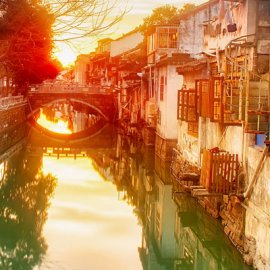Reinventing Canals
-
English
-
ListenPause
[intro music] Welcome to World Ocean Radio... I’m Peter Neill, Director of the World Ocean Observatory. On my life-list of travel dreams has been a full exploration of the Grand Canal in China, built 1400 years ago and stretching some 1700 kilometers to link two great urban areas, Hangzhou and the capital Beijing. The Grand Canal has been, and continues to be, an invisible highway, a linear community in and of itself, a connection that has enabled the transfer of goods south to north, internal migration, and a system of finance and economic connection that resembles the spine of a nation state – a dynamic structure, a nerve system for the transfer of goods and services, people and ideas. It has changed over the centuries, deteriorated with age, struggled with modernity just as we struggle with arthritis, externalities, accidental circumstance, compression and stress, and grow stiff and bent and inhibited from our past movement and vitality. On several trips to China, I tried to find ways that with only curiosity and no language I could immerse myself in that historicity and join that cultural flow; to no avail, of course; there is no tourism infrastructure available and, while it seemed possible to engage through daring and persuasion, to do so without fluency beyond halting Mandarin would be fool-hardy and fail. So it goes with travel dreams. China has other examples of north/south connecting canals, the Zheganyue from Hangzhou south to Guangzhou on the Pearl River Basin and the South China Sea, and the Xianggui from Yueyang to Quzhou. And just recently, it has announced construction of a first new canal, the Pinglu, that will allow vessels up to 5000 tons to move from the Xi River system to southern ports instead of Guangzhou, shortening the route to the sea by some 500 kilometers, involving construction of new locks, lifting bridge heights, and relocating shoreline inhabitants from the banks to higher ground. It is all part of a grand new system built on the old with modern utility and enormous cost. Rivers, of course, are natural canals, and in the United States, Europe, Asia, and parts of Africa they are long-established “highways,” along which production, trade, and international connections continue to be made. Recent headlines concerning climate-induced extreme drought conditions have not only caused that distribution system to be limited, in some cases, stopped as the water levels have declined and are no longer navigable. The supply chain implications have been made painfully obvious, just as the low water has revealed vestiges of the past, shipwrecks, submerged ports, and inundated cultural artifacts now exposed for the first time in centuries. Canals suddenly have new uses – as reservoirs to store rather than transfer accumulated water for local use or as built platforms for solar panels to provide alternative energy from the fossil fuels generation of the past. Some canals and rivers have become revitalized as recreational facilities or tourism amenity in the old downtowns of river cities. When I was young, living in St. Louis, Missouri, as far away from the ocean as possible in any direction, I would go down to the Mississippi as an open natural space in a congested midwestern city. I could see there birdlife, the giant river turtles that became my personal avatar, and hear the sounds of a movement, a continuity, even a history subverted, the echoes from the nearby old courthouse steps where, yes, once slaves were sold. Rivers as revelations. Beyond metaphor, our planet is organized and fed by the circulation of water, from mountaintop to abyssal plain, through an intricate interlocking architecture, that by movement, absorption, irrigation, and sustenance maintains our body, and our body politic. I return again to a vision of “hydraulic society,” community, worldwide, sustained and secured by the adequacy of water. We can no longer deny the depletion of water worldwide. The European rivers run dry; the California fields are brown, the forests on fire; record temperatures and evaporation continue to disrupt agriculture and public health. The town next door to where I live, on the ocean, must now import water by tanker truck for public service and sanitation. It is not a distant, ignorable problem any longer. We must re-invent canals and waterways. We must hydrate our communities and our bodies. We must put aside all the foolish pride, the political absurdities, the social conflict, the prideful war, to focus on what brings us together and sustains us. Strip away everything else, distill it all down to water, and allow its flow, in rivulets, natural conduits, melting ice, lakes and rivers, built canals , waterways, and pipes, penultimately into the ocean where it turns round again, mixes, to sustain our travel fantasies and hopeful dreams. We will discuss these issues, and more, in future editions of World Ocean Radio.
This week on World Ocean Radio we're talking about the circulation of water worldwide, and the importance of canals and waterways to bring us together and sustain us into the future.
About World Ocean Radio
5-minute weekly insights dive into ocean science, advocacy and education hosted by Peter Neill, lifelong ocean advocate and maritime expert. Episodes offer perspectives on global ocean issues and viable solutions, and celebrate exemplary projects. Available for syndicated use at no cost by college and community radio stations worldwide.
Image
Zhang Kaiyv on Unsplash
Suzhou, China
- Login to post comments



